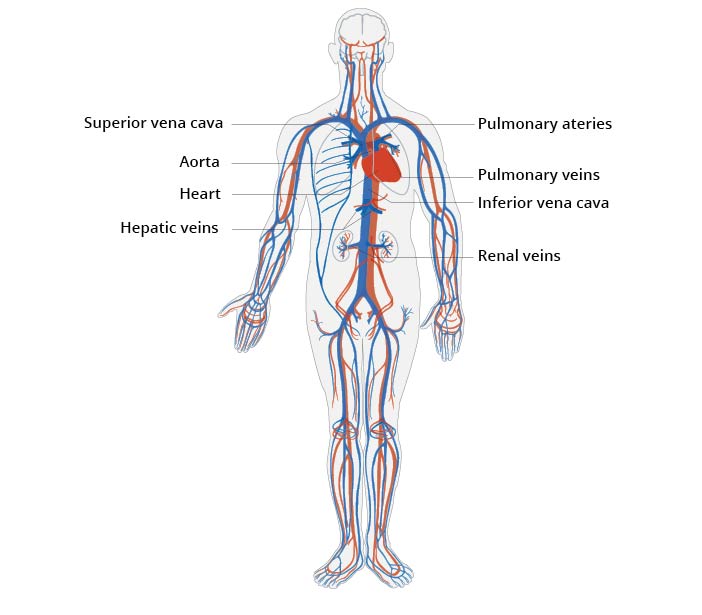The Cardiovascular System
What happens within the pulmonary circulation?
What happens within the systemic (bodily) circulation?
How is the cardiovascular system maintained?
What do you need to know about Cardiovascular Disease?
The heart is the center of the Cardiovascular System. It is a hollow muscle that pumps blood via blood vessels throughout the entire body, a process that happens in less than 60 seconds. The circulating blood not only supplies the tissues and organs with Oxygen and other nutrients, but also gets rid of waste material such as carbon dioxide. The Cardiovascular system is divided into two components: the pulmonary circulation and the systemic (bodily) circulation; these two systems are connected.

What happens within the pulmonary circulation?
The pulmonary circulation is responsible for exchanging carbon dioxide for oxygen, so that oxygen-rich blood can flow throughout the body. Veins are responsible for bringing oxygen-poor blood back to the heart so that this process can take place. Many small veins throughout the body join forces in two large veins when returning to the heart: the superior and inferior vena cavae. The inferior vena cava drains blood from below the diaphragm (the lower body), and the superior vena cava drains blood from above the diaphragm (the upper body). Both the superior and inferior vena cavae deliver oxygen-poor blood back into the right atrium of the heart. From the right atrium, blood flows through the tricuspid valve into the right ventricle, and further through the pulmonary valve into the pulmonary arteries. The blood is then carried to the lungs, where carbon dioxide is released and oxygen is collected. The newly oxygenated blood travels via the pulmonary veins back to the left side of the heart.
What happens within the systemic (bodily) circulation?
The systemic circulation begins in the left atrium, where newly oxygenized blood has just arrived from the lungs. The blood flows from the left atrium through the mitral valve into the left ventricle. The left ventricle then pumps blood through the aortic valve into the aorta (the main artery of the body), which sends the oxygen-rich blood to the body. The aorta has many branches, which give way to smaller vessels called arteries, and even smaller vessels known as arterioles. This network of vessels deliver blood all throughout the body, and allow for the exchange of Oxygen and other nutrients within the capillary network (the connection between the arterial and venous systems). After this exchange takes place, the blood is once again oxygen-poor (but rich in carbon dioxide). It is transported via venules (the venous counterpart to arterioles) and veins (the venous counterpart to arteries) into the superior or inferior vena cava, where the blood again enters the pulmonary circulation to become oxygenated.
How is the Cardiovascular System maintained?
The cardiovascular system requires a certain pressure in order to function; this pressure is called the blood pressure. The blood pressure is divided into the systolic and diastolic blood pressures. The systolic blood pressure is measured while the heart is contracting (squeezing). When the heart contracts, the pressure in the arteries and veins rises as well. This is the upper number on a blood pressure reading; the lower number is the diastolic blood pressure. The diastolic blood pressure is measured while the heart muscle is relaxing, also causing the pressure in the blood vessels to decrease. Read about the effects of elevated blood pressure on the cardiovascular system in our Specialty Article: High Blood Pressure.
What do you need to know about Cardiovascular Disease?
Cardiovascular disease is the most common type of disease, and is the number one cause of death in Germany. It is therefore particularly important to be informed about these diseases, and to take precautions in order to avoid their potential long-term complications.
Risk factors:
- Bradycardia
- Tachycardia
- Ventricular Arrhythmia
- Atrial Fibrillation
- Brugada Syndrome
Diseases:
- Coronary Artery Disease (CAD)
- Valvular disorders
- Heart muscle inflammation
- Cardiomyopathy
- Peripheral artery disease (PAD)
- Stroke due to Atrial Fibrillation
- Sleep Apnea